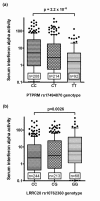Trait-stratified genome-wide association study identifies novel and diverse genetic associations with serologic and cytokine phenotypes in systemic lupus erythematosus
- PMID: 20659327
- PMCID: PMC2945049
- DOI: 10.1186/ar3101
Trait-stratified genome-wide association study identifies novel and diverse genetic associations with serologic and cytokine phenotypes in systemic lupus erythematosus
Abstract
Introduction: Systemic lupus erythematosus (SLE) is a highly heterogeneous disorder, characterized by differences in autoantibody profile, serum cytokines, and clinical manifestations. SLE-associated autoantibodies and high serum interferon alpha (IFN-α) are important heritable phenotypes in SLE which are correlated with each other, and play a role in disease pathogenesis. These two heritable risk factors are shared between ancestral backgrounds. The aim of the study was to detect genetic factors associated with autoantibody profiles and serum IFN-α in SLE.
Methods: We undertook a case-case genome-wide association study of SLE patients stratified by ancestry and extremes of phenotype in serology and serum IFN-α. Single nucleotide polymorphisms (SNPs) in seven loci were selected for follow-up in a large independent cohort of 538 SLE patients and 522 controls using a multi-step screening approach based on novel metrics and expert database review. The seven loci were: leucine-rich repeat containing 20 (LRRC20); protein phosphatase 1 H (PPM1H); lysophosphatidic acid receptor 1 (LPAR1); ankyrin repeat and sterile alpha motif domain 1A (ANKS1A); protein tyrosine phosphatase, receptor type M (PTPRM); ephrin A5 (EFNA5); and V-set and immunoglobulin domain containing 2 (VSIG2).
Results: SNPs in the LRRC20, PPM1H, LPAR1, ANKS1A, and VSIG2 loci each demonstrated strong association with a particular serologic profile (all odds ratios > 2.2 and P < 3.5 × 10-4). Each of these serologic profiles was associated with increased serum IFN-α. SNPs in both PTPRM and LRRC20 were associated with increased serum IFN-α independent of serologic profile (P = 2.2 × 10-6 and P = 2.6 × 10-3 respectively). None of the SNPs were strongly associated with SLE in case-control analysis, suggesting that the major impact of these variants will be upon subphenotypes in SLE.
Conclusions: This study demonstrates the power of using serologic and cytokine subphenotypes to elucidate genetic factors involved in complex autoimmune disease. The distinct associations observed emphasize the heterogeneity of molecular pathogenesis in SLE, and the need for stratification by subphenotypes in genetic studies. We hypothesize that these genetic variants play a role in disease manifestations and severity in SLE.
Figures



References
Publication types
MeSH terms
Substances
Grants and funding
LinkOut - more resources
Full Text Sources
Medical
Molecular Biology Databases

